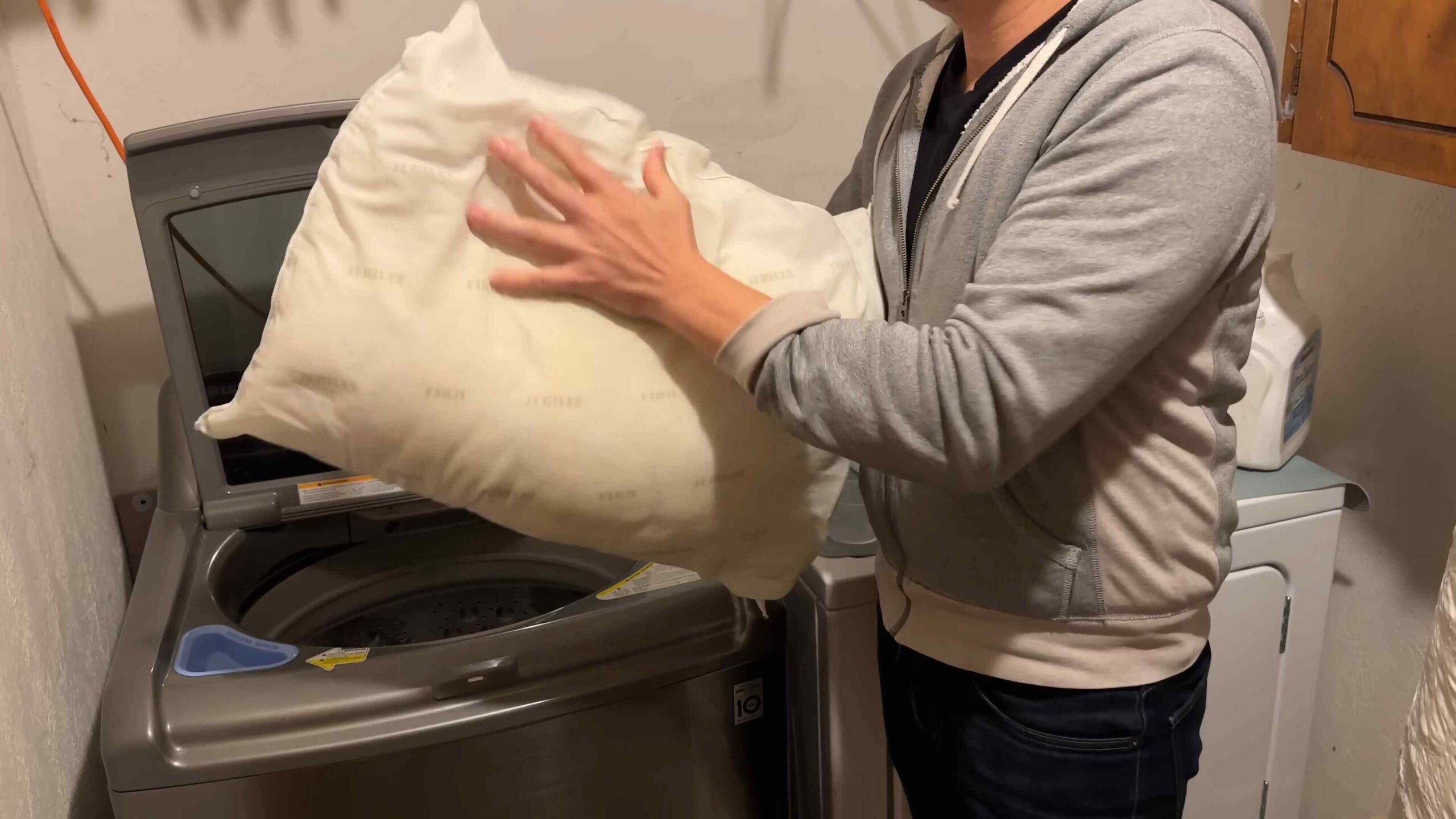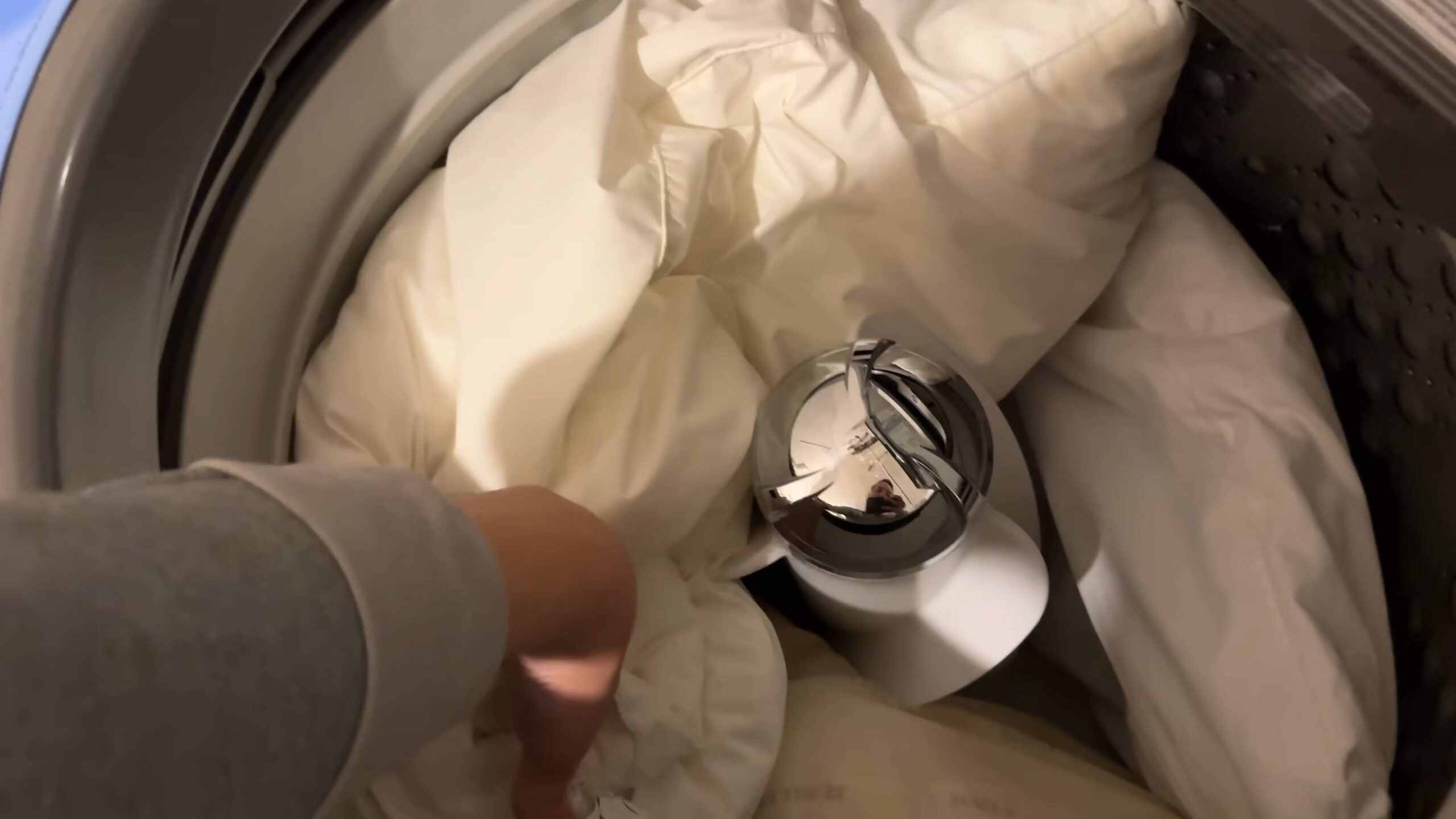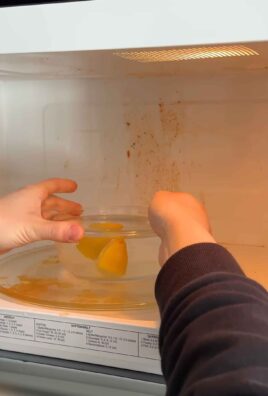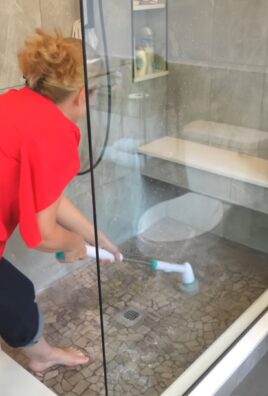Clean Pillows for Better Sleep: Are you tired of tossing and turning all night, only to wake up feeling groggy and unrested? You might be surprised to learn that the secret to a better night’s sleep could be as simple as cleaning your pillows! We often overlook our pillows when it comes to cleaning, but they can accumulate dust mites, dead skin cells, oils, and even mold over time. Yuck!
Throughout history, pillows have been symbols of comfort and luxury. From the hard, stone headrests of ancient Egypt to the feather-filled cushions of Renaissance Europe, people have always sought ways to elevate their sleep experience. But even the most opulent pillows can become breeding grounds for allergens if not properly maintained.
That’s where this DIY guide comes in! I’m going to share some simple, effective, and budget-friendly tricks to get your pillows sparkling clean. Not only will this improve your sleep quality by reducing allergens and irritants, but it will also extend the lifespan of your pillows, saving you money in the long run. Who doesn’t love a good money-saving hack? So, let’s dive in and discover how to achieve clean pillows for better sleep, starting tonight!

DIY: Revive Your Pillows for a Restful Night’s Sleep
Okay, let’s be honest, when was the last time you *really* cleaned your pillows? We wash our sheets religiously, but pillows often get neglected. They absorb sweat, oils, dust mites, and all sorts of other unpleasantness. A clean pillow isn’t just about hygiene; it’s about better sleep and overall well-being. So, let’s dive into how to give your pillows a proper spa day!
Why Clean Your Pillows?
Before we get started, let’s quickly cover why this is so important:
* Hygiene: Pillows harbor dust mites, dead skin cells, and body oils, creating a breeding ground for bacteria and allergens.
* Allergies: Dirty pillows can trigger allergies, asthma, and other respiratory issues.
* Skin Health: Sleeping on a dirty pillow can contribute to acne and other skin problems.
* Sleep Quality: A clean, fresh pillow simply feels better and promotes more restful sleep.
* Longevity: Regular cleaning extends the life of your pillows, saving you money in the long run.
What You’ll Need
Gather these supplies before you begin:
* Washing Machine: A top-loading or front-loading machine will work. If you have an agitator in your top-loader, be extra careful (more on that later).
* Laundry Detergent: Use a mild, liquid detergent. Powdered detergents can sometimes leave residue.
* Borax (Optional): Borax helps boost the cleaning power of your detergent and eliminate odors.
* White Vinegar (Optional): White vinegar acts as a natural fabric softener and helps remove detergent residue.
* Tennis Balls or Dryer Balls: These help fluff the pillows and prevent them from clumping in the dryer.
* Clean Towels: For drying the pillows.
* Clothesline or Drying Rack (Optional): For air-drying.
Checking the Care Label
This is crucial! Before you do anything, check the care label on your pillow. It will tell you the recommended washing instructions. Some pillows are machine washable, while others require dry cleaning or spot cleaning only. Ignoring the care label can damage your pillow.
Washing Machine-Safe Pillows: A Step-by-Step Guide
If your pillow’s care label says it’s machine washable, follow these steps:
1. Prepare Your Pillows: Remove pillowcases and any decorative covers. Give each pillow a good fluff to loosen any debris. Check for any rips or tears in the fabric. If you find any, mend them before washing to prevent the filling from escaping.
2. Load the Washing Machine: Wash two pillows at a time to balance the load. This prevents the washing machine from becoming unbalanced and potentially damaging it. Place the pillows vertically in the machine.
3. Add Detergent and Borax (Optional): Add the recommended amount of mild liquid laundry detergent to the dispenser. If you’re using borax, add about 1/2 cup to the drum of the washing machine.
4. Add White Vinegar (Optional): Pour 1/2 cup of white vinegar into the fabric softener dispenser.
5. Select the Wash Cycle: Choose the gentle or delicate cycle with warm water. A hot water cycle can damage some pillow fillings. Select an extra rinse cycle to ensure all detergent is removed.
6. Start the Washing Machine: Let the washing machine do its thing!
Drying Your Pillows: The Key to Fluffiness
Proper drying is just as important as washing. Here’s how to do it right:
1. Remove Pillows from the Washing Machine: Gently remove the pillows from the washing machine. They will be heavy and waterlogged, so handle them carefully.
2. Check for Remaining Stains: Before drying, inspect the pillows for any remaining stains. If you find any, spot treat them with a stain remover and rewash.
3. Tumble Dry on Low Heat: Place the pillows in the dryer with a few clean tennis balls or dryer balls. The tennis balls will help fluff the pillows and prevent them from clumping. Use the low heat setting to avoid damaging the filling.
4. Dry in Cycles: Dry the pillows in 30-minute cycles, checking them frequently. Fluff them by hand between cycles to redistribute the filling.
5. Ensure Complete Drying: It’s crucial to ensure the pillows are completely dry before using them. Damp pillows can develop mold and mildew. This might take several cycles. A good test is to feel for any dampness deep inside the pillow.
6. Air Drying (Optional): If you prefer, you can air dry your pillows. Place them on a clothesline or drying rack in a well-ventilated area. Turn them regularly to ensure even drying. Air drying can take significantly longer than machine drying.
Dealing with Specific Pillow Types
Different pillow fillings require different care. Here’s a quick guide:
* Down and Feather Pillows: These are generally machine washable, but follow the care label carefully. Use a gentle detergent and dry on low heat with tennis balls.
* Polyester Pillows: These are usually the easiest to wash and dry. Use a gentle cycle and low heat.
* Memory Foam Pillows: Do not machine wash memory foam pillows! The agitation can damage the foam. Spot clean them with a mild detergent and water. Air dry them completely.
* Latex Pillows: Similar to memory foam, latex pillows should not be machine washed. Spot clean them and air dry them away from direct sunlight.
* Buckwheat Pillows: Empty the buckwheat hulls before washing the pillow cover. The hulls themselves cannot be washed. Wash the cover on a gentle cycle and dry on low heat. Refill the cover with the buckwheat hulls after it’s completely dry.
Special Considerations for Top-Loading Washing Machines with Agitators
Top-loading washing machines with agitators can be rough on pillows. Here’s how to minimize the risk of damage:
* Use a Mesh Laundry Bag: Place each pillow in a large mesh laundry bag to protect it from the agitator.
* Wash One Pillow at a Time: This will reduce the stress on the pillow and the washing machine.
* Use the Gentle Cycle: Always use the gentle or delicate cycle.
* Skip the Spin Cycle: If possible, skip the spin cycle to prevent excessive agitation.
Spot Cleaning Your Pillows
Sometimes, your pillows just need a little spot cleaning. Here’s how to do it:
1. Identify the Stain: Determine the type of stain (e.g., coffee, blood, oil).
2. Mix a Cleaning Solution: Mix a small amount of mild detergent with water.
3. Apply the Solution: Dip a clean cloth into the cleaning solution and gently blot the stain. Avoid rubbing, as this can spread the stain.
4. Rinse with Clean Water: Use a clean, damp cloth to rinse the area.
5. Blot Dry: Blot the area with a clean, dry cloth to remove excess moisture.
6. Air Dry: Allow the pillow to air dry completely.
How Often Should You Clean Your Pillows?
Aim to wash your pillows every 3-6 months. Spot clean them as needed. You should also replace your pillows every 1-2 years, depending on their quality and condition.
Tips for Keeping Your Pillows Clean Longer
* Use Pillow Protectors: Pillow protectors are zippered covers that go over your pillows and under your pillowcases. They provide an extra layer of protection against dust mites, allergens, and spills.
* Wash Your Pillowcases Regularly: Wash your pillowcases at least once a week in hot water.
* Air Out Your Pillows: Regularly air out your pillows in the sun to kill bacteria and freshen them up.
* Avoid Eating in Bed: Crumbs and spills can attract pests and create stains.
Troubleshooting Common Pillow Cleaning Problems
* Pillows are Still Stained After Washing: Pre-treat stains with a stain remover before washing. For stubborn stains, try soaking the pillows in a solution of water and borax before washing.
* Pillows are Lumpy After Drying: Fluff the pillows by hand and dry them in cycles with tennis balls. If the lumps persist, try gently massaging the filling to redistribute it.
* Pillows Smell Musty After Drying: This indicates that the pillows were not completely dry. Rewash and dry them thoroughly. Add white vinegar to the wash cycle to help eliminate odors.
* Pillow Filling is Coming Out: Mend any rips or tears in the fabric before washing. Use a mesh laundry bag to protect the pillows during washing.
By following these steps, you can keep your pillows clean, fresh, and comfortable for years to come. Sweet dreams!

Conclusion
So, there you have it! A simple, effective, and surprisingly satisfying way to breathe new life into your pillows and, consequently, your sleep. We’ve walked you through the process of cleaning your pillows, a task often overlooked but absolutely crucial for maintaining a healthy and restful sleep environment. Think about it: you spend approximately a third of your life with your face pressed against these cushions. Over time, they accumulate dust mites, dead skin cells, oils, and even mold, all of which can contribute to allergies, skin irritations, and generally poor sleep quality.
This DIY pillow cleaning method isn’t just about hygiene; it’s about investing in your well-being. A clean pillow is a more supportive pillow, allowing for proper spinal alignment and reducing neck pain. It’s also a more comfortable pillow, free from the musty odors and lumpy fillings that can disrupt your sleep.
But the benefits don’t stop there. By choosing to clean your pillows yourself, you’re also saving money and reducing waste. Professional cleaning services can be expensive, and replacing pillows frequently adds to landfill waste. This method allows you to extend the lifespan of your existing pillows, making it a more sustainable and budget-friendly option.
Why is this DIY trick a must-try? Because it’s a holistic approach to better sleep. It addresses the often-ignored issue of pillow hygiene, offering a simple, affordable, and environmentally conscious solution. It’s about taking control of your sleep environment and creating a space that promotes relaxation and rejuvenation.
Looking for variations? Consider adding a few drops of your favorite essential oil to the washing machine during the rinse cycle. Lavender, chamomile, and eucalyptus are all excellent choices for promoting relaxation and sleep. You could also try using a different type of detergent, such as a hypoallergenic or fragrance-free option, if you have sensitive skin or allergies. For down pillows, consider adding a few tennis balls or dryer balls to the dryer to help fluff them up and prevent clumping. Ensure the tennis balls are clean and placed inside clean socks to prevent any dye transfer.
We understand that the thought of washing your pillows might seem daunting, but trust us, it’s easier than you think. The steps are straightforward, and the results are well worth the effort. Imagine sinking into a freshly cleaned pillow, knowing that you’re breathing in clean, fresh air and giving your body the support it needs for a restful night’s sleep.
So, what are you waiting for? Give this DIY pillow cleaning trick a try and experience the difference for yourself. We’re confident that you’ll be amazed at how much better you sleep. Don’t just take our word for it – try it and see!
We encourage you to share your experiences with us. Did you find this method helpful? Did you try any variations? What tips and tricks do you have for keeping your pillows clean and fresh? Share your thoughts in the comments below, and let’s create a community of well-rested individuals! Let us know if this method for clean pillows has helped you get a better night’s sleep.
Frequently Asked Questions (FAQs)
How often should I clean my pillows?
This is a common question, and the answer depends on several factors, including your sleeping habits, allergies, and the type of pillow you have. As a general guideline, it’s recommended to wash your pillows at least twice a year, or even more frequently if you have allergies or tend to sweat a lot during the night. If you use a pillow protector, you may be able to extend the time between washes, but it’s still important to clean your pillows regularly to maintain hygiene and prevent the buildup of dust mites and allergens. Consider washing them every 2-3 months if you have allergies.
What type of detergent should I use?
For most pillows, a mild, liquid detergent is best. Avoid using harsh chemicals or bleach, as these can damage the filling and irritate your skin. If you have sensitive skin or allergies, opt for a hypoallergenic or fragrance-free detergent. For down pillows, use a detergent specifically designed for delicate fabrics. Always follow the manufacturer’s instructions on the detergent label.
Can I wash all types of pillows in the washing machine?
While many pillows can be safely washed in the washing machine, it’s always important to check the care label first. Some pillows, such as those made of memory foam or latex, may require special cleaning methods. Memory foam pillows, for example, should typically be spot cleaned or hand washed, as machine washing can damage the foam. Latex pillows may be machine washed on a gentle cycle, but it’s important to dry them properly to prevent mildew. If you’re unsure, it’s always best to err on the side of caution and consult the manufacturer’s instructions or a professional cleaning service.
How do I dry my pillows properly?
Proper drying is crucial to prevent mildew and ensure that your pillows are completely dry. For most pillows, tumble drying on low heat is the best option. Add a few tennis balls or dryer balls to the dryer to help fluff up the pillows and prevent clumping. Check the pillows frequently during the drying process and redistribute the filling as needed. Down pillows may take longer to dry than synthetic pillows, so be patient and allow them to dry completely. If you prefer to air dry your pillows, make sure to place them in a well-ventilated area and turn them regularly to ensure even drying. Avoid drying pillows in direct sunlight, as this can damage the filling.
How do I know when it’s time to replace my pillows?
Even with regular cleaning, pillows eventually wear out and need to be replaced. A good rule of thumb is to replace your pillows every 1-2 years, or sooner if they are no longer providing adequate support or have become lumpy or misshapen. You can also perform the “fold test” to check the condition of your pillows. Simply fold the pillow in half and see if it springs back into shape. If it stays folded or doesn’t return to its original shape, it’s time to replace it. Other signs that it’s time for new pillows include persistent neck pain, allergies, or difficulty sleeping.
What about pillow protectors? Are they really necessary?
Yes, pillow protectors are highly recommended. They act as a barrier against dust mites, allergens, and spills, helping to keep your pillows clean and fresh for longer. Pillow protectors are also much easier to wash than pillows, so they can help to extend the lifespan of your pillows. Look for pillow protectors that are made of breathable materials, such as cotton or microfiber, and that are waterproof or water-resistant.
Can I use baking soda or vinegar to clean my pillows?
Baking soda and vinegar are natural cleaning agents that can be used to freshen up your pillows. Adding a cup of baking soda to the washing machine can help to remove odors and brighten the fabric. Vinegar can also be used as a natural fabric softener and can help to remove stains. However, it’s important to use these ingredients sparingly and to avoid mixing them together, as they can react and create a less effective cleaning solution. Always test a small, inconspicuous area of the pillow first to ensure that the baking soda or vinegar doesn’t damage the fabric.
My pillows have yellow stains. How can I remove them?
Yellow stains on pillows are often caused by sweat, oil, and saliva. To remove these stains, you can try pre-treating the pillows with a stain remover or a mixture of baking soda and water. Apply the stain remover or baking soda paste to the stained area and let it sit for at least 30 minutes before washing the pillows as usual. For stubborn stains, you may need to repeat the process or use a stronger stain remover. Avoid using bleach, as this can damage the fabric and cause discoloration.
What if my pillows have a musty smell even after washing?
A musty smell after washing can indicate that the pillows were not dried properly or that there is still moisture trapped inside. To remove the musty smell, try re-washing the pillows with a cup of vinegar and then drying them thoroughly in the dryer with dryer balls. You can also try placing the pillows in direct sunlight for a few hours to help kill any remaining bacteria or mold. If the musty smell persists, it may be time to replace the pillows.
Are there any other tips for keeping my pillows clean and fresh?
In addition to washing your pillows regularly, there are several other things you can do to keep them clean and fresh. Fluff your pillows daily to help redistribute the filling and prevent clumping. Use pillow protectors to protect your pillows from dust mites, allergens, and spills. Air out your pillows regularly by placing them in a well-ventilated area. Avoid eating or drinking in bed, as this can lead to spills and stains. And finally, consider investing in high-quality pillows that are designed to be durable and easy to clean.





Leave a Comment